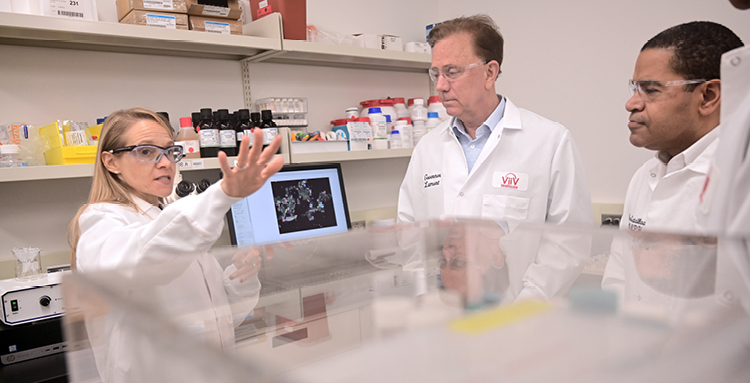Connecticut Leads in Anti-Viral R&D

Every member of the Connecticut Bioscience Growth Council was involved in combating the COVID-19 pandemic, whether in developing tests to reveal the presence of the virus, vaccines to prevent infection, or treatments, like Pfizer’s Paxlovid.
The pandemic made us all much more aware of the latter category of drugs, anti-virals. What’s less well known is the central role Connecticut played—and continues to play—in anti-viral research and development.
Viruses are often confused with bacteria, though they are quite different. Bacteria are living cells that absorb nutrients (eat), move, and reproduce.
It’s a stretch to describe viruses, on the other hand, as living organisms—they’re fragments of genetic material and grow and reproduce only by inserting themselves into and using the machinery of the host cells they infect.
Fighting Viruses
As a class, viruses are about 10 times smaller than a typical bacterium. Many are hundreds of times smaller than the cells they invade.
Bacteria can be seen easily in a simple, not-very-powerful, microscope, the kind you might have used in middle- or high-school.
Viruses can be seen only with the aid of very sophisticated electron microscopes.
Given the small size of viruses, figuring out how to devise anti-viral medications proved much more difficult.
Starting with penicillin in the 1920s, antibiotics came to the rescue for treatment of bacterial infections, like staph or tuberculosis.
Given the small size of viruses—how they slip largely undetected into cells and use their cell hosts to massively reproduce—figuring out how to devise anti-viral medications proved much more difficult.
The obvious way to a kill a virus would be kill its host cell, but if the host cell is critical to life, say a liver or heart cell, that approach is not an option.
HIV Accelerated Breakthroughs
Though the first effective anti-virals were developed in the 1960s to treat herpes simplex, broad understanding of how viruses infect and replicate in cells did not occur until the advent of the HIV/AIDs epidemic in the 1980s.
Much of the groundbreaking HIV R&D was done by Yale researchers and at BMS’ Wallingford research facility.
Much of the groundbreaking HIV R&D was done by Yale researchers and at BMS’ Wallingford research facility.
That R&D has made HIV a highly manageable disease, with anti-viral drugs bringing most patients’ viral load to infinitesimal, almost undetectable, levels.
Anti-viral medications now afford HIV patients a near normal life expectancy.
That Connecticut is the cutting-edge of anti-viral R&D is apparent in Pfizer-Groton’s unprecedented mobilization to develop and produce, in a very short timeframe, an effective COVID vaccine, and at ViiV Healthcare.
Branford’s ViiV Tackles HIV
ViiV, based in Branford, is majority owned by GSK (Pfizer also has a stake in the company) and has 17 anti-viral medications under investigation.
For HIV, the company has developed streamlined dosing regimens, including a two-drug single tablet product and the first long-acting injectable treatment.

It’s estimated that 1.2 million people in the U.S. are living with HIV, with at least 13% unaware that they are infected with the virus.
ViiV’s a leader in developing and bringing to market innovative ways to deliver long-acting HIV preexposure prophylaxis (PrEP) medicines that, if taken prior to exposure, act to block HIV infection.
These drugs are critical to the U.S. Department of Health and Human Services’ program to end the HIV epidemic and Connecticut’s Getting to Zero campaign.
Legislation
Two bills before the Connecticut General Assembly this legislative session support efforts to dramatically reduce, and perhaps eliminate, HIV infection.
SB 1102 authorizes pharmacies and pharmacy technicians to administer HIV tests and prescribe and dispense HIV prophylaxis medications.
This bill, which passed the Senate and is waiting action in the House, will significantly simplify the path to treatment for HIV.
SB 1102 will significantly simplify the path to treatment for HIV.
SB 1068, currently awaiting action by the Senate, provides financial assistance to underserved individuals in need of pre-exposure and post-exposure prophylaxis to prevent HIV infection.
In Connecticut, while the rate of people living with HIV by race and ethnicity was higher in minority populations, the rate of PrEP usage is 67.5% for white, 19.4% for Hispanic/Latino/Latina, and 9.6% Black/African American.
The Bioscience Growth Council has been a strong advocate for this legislation.
The bills build on ViiV’s success in developing new anti-virals and combating HIV, and makes the state’s support for the buildout of ViiV’s Branford research facility one of Connecticut’s most impactful economic development investments.
Paul Pescatello is the executive director of CBIA’s Bioscience Growth Council and chair of We Work For Health Connecticut. Follow him on Twitter @CTBio.
RELATED
EXPLORE BY CATEGORY
Stay Connected with CBIA News Digests
The latest news and information delivered directly to your inbox.


